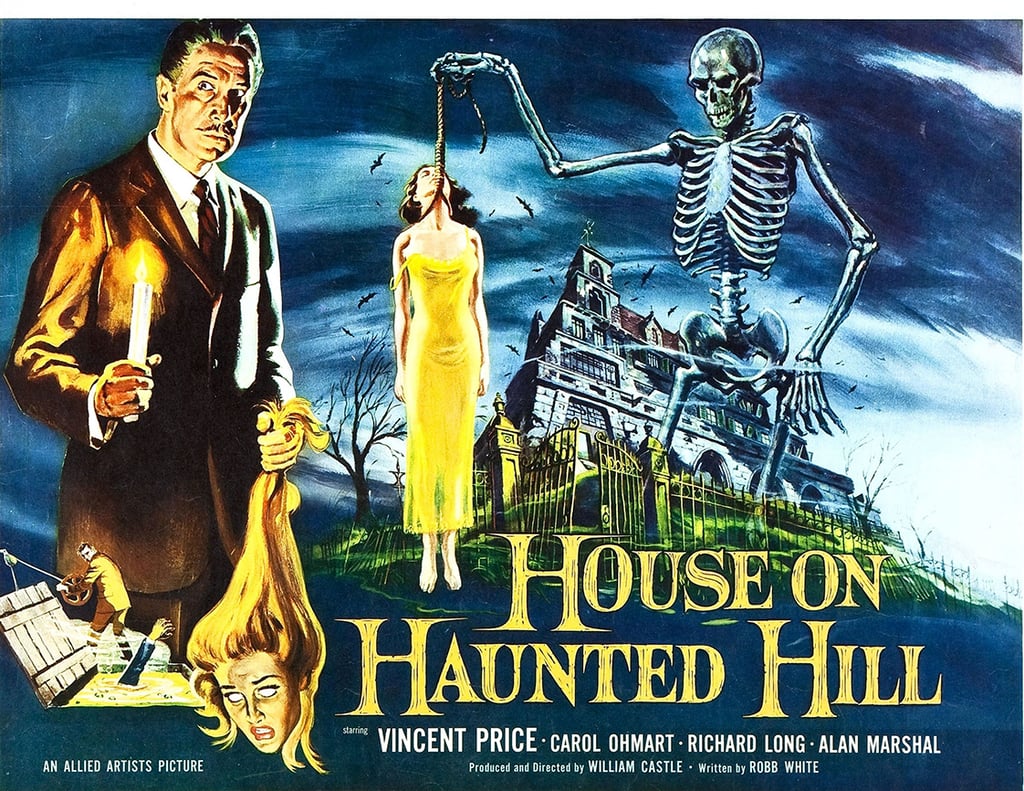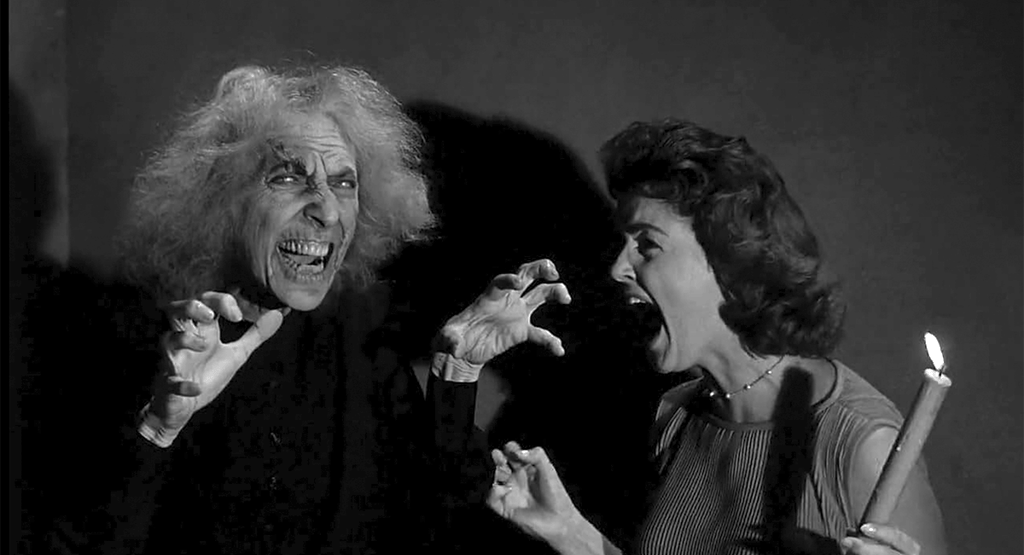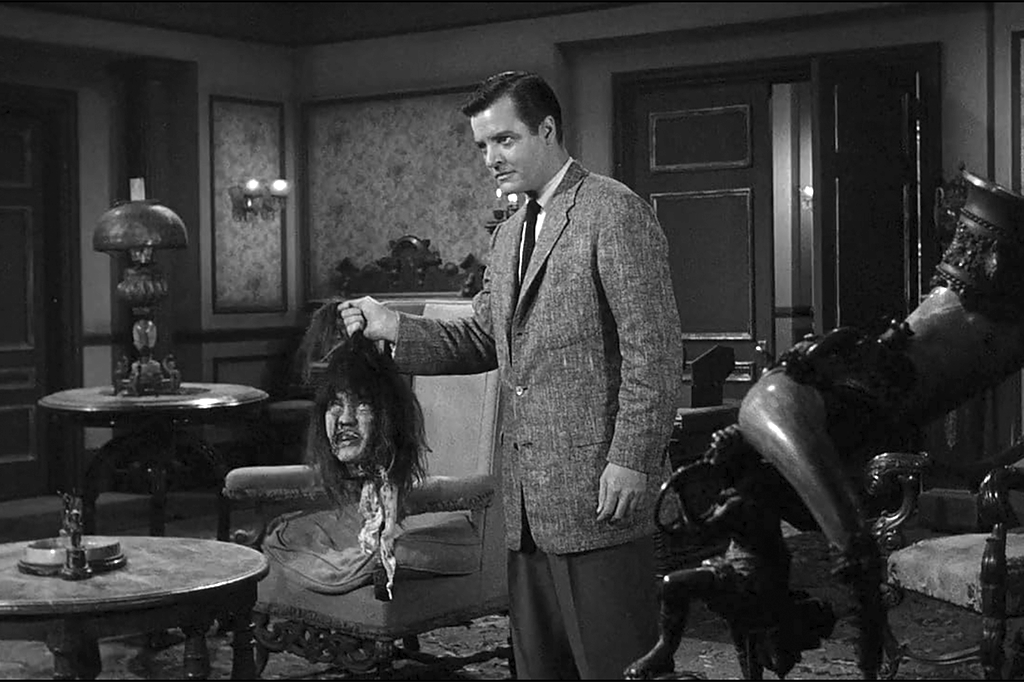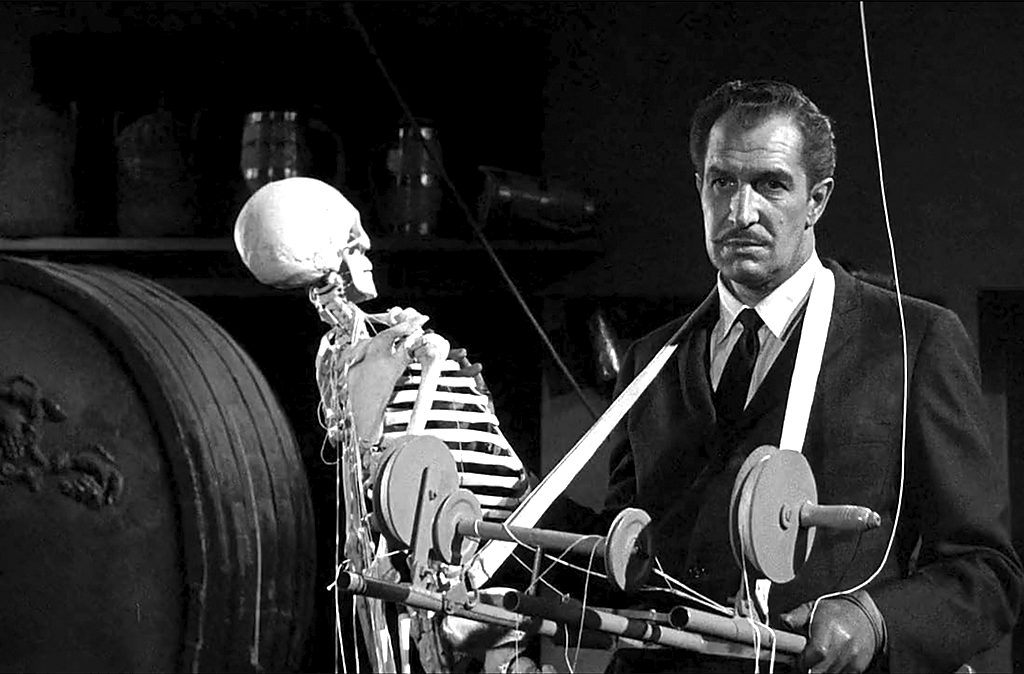Do you love dark cinema like we do?
House on Haunted Hill
After appearing in House of Wax in 1953, this film solidified Vincent Price's position in horror cinema with House on Haunted Hill, playing the only ghoul in the house. 1 HR 15 MINS 1959 Allied Artists
HORROR/SCIENCE FICTION
by Gary Svehla
10/21/202513 min read


After highlighting the Allied Artists logo, which appears in white against a black background, it slowly fades away, and darkness hovers for several seconds, keeping the audience in suspense. Several seconds later, horrifying female screams emerge from the screen, filled with deep groans and alternating male background screams, all against a black background. Then, the intense face of Elisha Cook appears in the center of the screen, drawing closer to the audience, and says, “The ghosts are moving tonight, restless and hungry. May I introduce myself? I’m Watson Pritchard. In a minute, I’ll show you the only truly haunted house in the world. Since it was built a century ago, seven people—including my brother—have been murdered there. I’ve owned the house ever since. I only spent one night inside, and when they found me in the morning, I was nearly dead! Then, Cook’s head pulls back from the screen, still displaying an intense expression. Next, a shot of the Ennis House appears, and Vincent Price’s head hovers in front of the haunted house, slowly drawing closer to the audience again. “I’m Frederick Loren, and I’ve rented the house on haunted hill tonight so my wife can host a haunted house party. Price’s face looks morbidly solemn, with flashes of sarcasm, smirking, and breaking into subtle laughter. She’s so amusing,” (Price deadpans). “Every food, drink, ghost, and perhaps even a few murders … You’re all invited! If any of you spent the next 12 hours in this house, I would give each of you $10,000—or your next of kin if you don’t survive.”
“Ah, here come our other guests! Vincent Price’s floats back into the darkness as several cars traverse dark, twisty roads leading to the house. “It was my wife’s idea for the guests to arrive in funeral cars. Her sense of humor, shall we say, is original. I dreamed of the hearse, which is empty now, but after a night in the house on haunted hill, who knows? This is Lance Schroeder (Richard Long), a test pilot — no doubt a brave man — but don’t you think you can be much braver if you’re paid for it? And I happen to know Lance needs the $10,000 I’ll give him if he’s brave enough to stay all night. This is Ruth Bridges (Julie Mitchum, Robert’s sister). You no doubt read her column in the newspapers. She said the reason she came to the party was to write a feature article on ghosts. She’s also desperate for money … gambles. You already met Watson Pritchard, a man living in moral fear of a house. He is risking his life to spend another night here. And I wonder why? He says for money. This is Doctor David Trent (Alan Marshall), a psychiatrist. He claims that my ghosts might help his work on hysteria, but don’t you see a little touch of greed there, (At this point, Marshall slyly looks directly at the camera) around the mouth and eyes? This is Nora Manning. I picked her from the thousands of people who work for me because she needed the $10,000 more than most. She supports her whole family. Isn’t she pretty? All the funeral cars follow the lead hearse up the hill in darkness and rain. “The party’s starting now. And you have until midnight to find the house on haunted hill. Eerie music sounds as the cars enter the vicinity of the house, as the opening credits appear.
House on Haunted Hill was a childhood favorite for every Boomer in the late 1950s, marking Castle’s return to dark cinema after his string of 1940s B movies, his first film since Macabre a year earlier. Here, William Castle elevated Robb White, the screenwriter of Macabre, to co-producer and also made him the screenwriter for House on Haunted Hill. Their creative partnership lasted four years and marked Castle’s golden era in film. He was a creative director and producer who knew how to craft films aimed at a date-night audience and used clever marketing to promote both the films and his own name. Robb White wrote formulaic stories that enchanted children and young adults while still appealing to adults, whose attendance they sought. From 1959 to 1961, the duo devised a successful formula that combined exploitation tricks, quality scares, veteran stars, William Castle’s name recognition, and a sense of fun, making each film a memorable cinematic experience.
The movie was based on several terrifying incidents creatively connected. The story was quite simple: a group of unrelated people is offered $10,000 to stay in the house overnight, but, of course, there’s more to it, and a friendly skeleton (called Emergo) emerging from the screen for the climax is just the icing on the cake. Let’s look at the key fright sequences together.
When the strangers first enter the house, they see cobwebs, old furniture, doors that close by themselves, and Nora is almost crushed by a swinging chandelier, which suddenly falls. Nora is saved by the heroic Lance, who, observing the guests down below, is Frederick Loren.
Watson Pritchard pulls a large knife from a small cabinet and displays it to the others. “This is what she used on my brother and her sister … hacked them to pieces … we found parts of the bodies all over the house, in places you wouldn’t think. A funny thing, the heads have never been found. Hands and feet and things like that, but no heads … you can hear them at night, they whisper to each other … and then cry.” This sequence will be tied to another later.
Pritchard takes the people on a tour of the house. He pauses at a dry, blood-stained corner of the ceiling. “See that stain … blood! A young girl was killed here. And whatever got her wasn’t human.” Ruth moves to get a better view, but Pritchard abruptly warns her not to stand there. Huge drops of blood immediately drip onto her outstretched hand. “It’s too late, they marked you!” Pritchard says.
Descending into the cellar, where one room is filled with wine vats, Pritchard says, “All this belonged to a Mr. Norton, who didn’t die here. He was electrocuted later. Mr. Norton did a lot of experimenting with wine.” Pritchard is turning a metal wheel, opening a trap door in the floor. “But his wife didn’t think any of it was good. So he built a vat with acid and threw her in. She was supposed to stay down, but the bones came up. It’s a funny thing, but none of the murders here were ordinary. No shooting or stabbing… they’ve all been kind of wild. Violent and different.” Pritchard is interrupted when Nora almost falls into the vat. Nora asks if there’s still acid in there, and Pritchard grabs a dead rat and throws it in. “Dissolves everything with hair and flesh,” the rat being dropped in and bubbling acid does its job, the rat’s bones rising to the surface.
We follow Nora knocking on the door beside the major acid vat in the basement, a room Lance entered, and the door slams shut. Failing to get inside, Nora watches as the lights dim and a shimmering sound grows louder, then vanishes multiple times. From another dark room, a white-haired hag appears, oddly approaching, then returns to the darkness. Nora runs up the stairs to the first floor. Catching people’s attention, she rushes downstairs to find Lance’s room unlocked, with Lance lying semi-conscious on the floor with a bloody forehead.
Later, Lance and Nora, each with a candle, venture into the room where Lance “hit his head.” “Someone or something was in here when I came in. But where? Since the door was locked, how did it get out?' “What you saw might have been a ghost, Nora, but what was in here with me was no ghost.” Lance moves along one wall, knocking and listening for a hollow spot. The two step outside the room, which measures about 12 feet, to the next small room. Lance tells Nora he’ll go knock on the first wall while she listens by knocking on this wall. Lance yells from the other side for her to hit the wall lower, so she crouches down holding her candle. Nora then gets up and turns around, suddenly confronting the frozen form of the witch-like woman, her hands appear as claws in front of her, causing Nora to scream. The old woman then seems to glide out of the room past Nora, as if on roller skates. After a few seconds, Lance re-enters the room, comforting Nora. He laughs and says he didn’t see the old hag floating outside, finding it hard to believe Nora, which insults her, and she storms out. This jump scare always made most teenage audiences jump when I showed the movie in my World of Movies classes over the years. People who couldn’t stand old black-and-white movies were scared to death by this one.
Nora is in her room preparing to meet the others downstairs just before 12 when she opens a small suitcase and sees a bloody head, one of the heads missing from the Pritchard brother murders. Nora screams in terror. While exploring the hall outside her room, it appears that a butler cups his hand around his mouth and says, “Come with us before he kills you!” Nora once again runs away screaming. She then shows the others her closed mini-suitcase in her bedroom. The bloody head is gone. But later, when Lance checks on Nora, who has left her room, the severed head hangs from the closet.
Running down to the main party room, the squeaky door opens to reveal the witchy woman and the spooky butler. That’s Jonas Slide and his wife, as introduced by Frederick Loren, as the caretakers of this house. “She’s blind, you know,” Nora shouts that she will not stay the night here. It is 11:50, and Loren is offering his guests the option to leave with the caretakers or be forced to remain all night. The wind rattles the chandelier, and a violent gust blows through the house as everyone hears a loud locking sound. The caretakers leave before midnight, which is highly unusual, trapping the guests inside all night. Mr. Loren offers his guests party favors, pistols housed in miniature coffins.
When talking to Pritchard about the missing Nora, we hear a woman scream, followed by a gagging sound. Lance rushes to investigate and finds Mrs. Loren's body hanging above the staircase. Dr. Trent and Lance lower her and carry her to her bedroom. At that moment, Frederick enters the room to find his wife dead.
After hiding Nora, who has resurfaced, Lance has to attend a meeting in the living room and makes sure Nora remains out of sight. Dr. Trent asks Frederick if there is a way to get out of the house now, and he shakes his head no. The guests agree to remain inside their rooms, armed with a pistol, the whole evening.
While Lance searches for a way out of the house, Nora remains alone in her room during a violent thunderstorm, with the lights flickering. A rope slowly crawls upward inside her room, through the barred window, with no one pulling on it. The end of the rope attaches itself to Nora’s feet, wrapping around her. Outside, the illuminated form of Mrs. Loren appears, with the other end of the rope wrapped around her neck. Her body moves closer to the outside window. Then, it moves back, unwrapping the rope from Nora’s feet. The rope eventually pulls itself outside the window. Nora foolishly runs out of her room and sees Mrs. Loren hanging by a noose from the ceiling, motionless. She screams, backing herself against a half-closed door, as a monstrous hand reaches toward her. She sees the hand, screams, and runs as the hand disappears behind the door. Nora then wanders into the living room, where an organ plays by itself.
Dr. Trent goes to the room where Annabelle’s corpse lies motionless. Trent says, “It’s almost over, darling. Every detail was perfect.” Annabelle’s supposed corpse stirs, smiles, and rises. She asks, “What’s happening?” Trent answers, “We’ve done it … the perfect crime, beautiful!” Annabelle further questions, “Has she killed him?” Trent says not yet, but she will! Annabelle asks Trent to help her out of this hanging harness. Dr. Trent says her appearance at Nora’s window drove her to complete hysteria, and now they both are headed to the cellar, where emotion will take over.
Nora enters the cellar, armed with her pistol. Frederick arrives shortly after, also with his pistol. Nora fires at Loren, and a hit to the chest causes him to slowly collapse to the floor. Dr. Trent enters from a side door, opens the acid vat, and slides Loren’s body toward it. Suddenly, the cellar turns completely black, with no lights, as we hear a groan, a splash, and bubbling sounds. Annabelle, hearing the gunshot, descends into the cellar, and the lights come on. She gently calls David’s name, but is met with squeaky doors shutting all by themselves. The acid vat remains open and bubbling as a slowly rising, intact human skeleton emerges from it. As the skeleton nearly frees itself from the vat, Annabelle desperately tries to escape, only to find all the doors locked. The skeleton speaks in Frederick’s voice, calling her a murderess, with its bony hand on her shoulder. She is gradually forced to walk backward toward the acid vat. Annabelle screams hysterically until the skeleton’s smallest push sends her into the vat. The camera then pans around the cellar to reveal Frederick Loren emerging from the shadows, wearing and controlling a large marionette rig. The wires connect the skeleton to the puppet. “Goodnight, doctor, goodnight Annabelle. The crime you both planned was indeed perfect. Only the victim is alive, and the murderers are not. It’s a pity you didn’t realize from the start that I was playing too,” he says.
Pritchard, Bridges, Nora, and Schroeder go down to the cellar, Nora thinking she’s shot and killed Frederick Loren, when they find him standing solemnly alone. Loren tells Nora that she didn’t shoot anyone; her gun was loaded with blanks. Loren briefly explains his account of the crimes.
Pritchard melodramatically utters, “Now they’re nine. There’ll be more, many more. They’re coming for me now, and then they’ll come for you!” Scenes from the haunted house follow, with ghostly hollering accompanying the soundtrack. As the front door slams shut, “the end” and studio logo appear.
As we see, the scenario appeals to the younger trade, but Robb White also infuses his story with adult elements, appealing to both the young and the old. Once the chandelier falls, Frederick ducks into Annabelle’s room. “Annabelle, our guests are here and unfortunately still alive. Your face on yet?” Annabelle enters, only wearing an inappropriate dress for a party, “Dust and dirt everywhere … didn’t you have the place cleaned?” Loren snaps back, “Atmosphere, darling. You know how ghosts are, they never tidy up. That’s a very fetching outfit, but hardly suitable for a party.” Annabelle smiles and says she isn’t going to the party. Frederick reminds her that the party was her idea. “Since this party is going to cost me $50,000, I want you to have fun. Annabelle says, “The party was my idea until you invited all the guests. Why the strangers? Why none of our friends?” Frederick sarcastically adds, “Friends, do we have any friends?” Annabelle smiles, uttering, “Your jealousy took care of that!” Frederick continues, “I had a reason for inviting each guest. I wanted a type of cross-section … from psychiatrist to typist, and from drunk to jet pilot. They share one thing: they all need money. Now let’s see if they’re brave enough to earn it.
Annabelle interjects, “ And you call this a party?” Frederick smiles, saying, “Could be.” Frederick reaches for a bottle of chilled champagne, shaking the bottle. Then he aims the cork at his wife, who says the bottle never explodes. Frederick, still pointing the bottle at Annabelle, says, “It would make a good headline, Playboy kills wife with champagne cork.” Then he safely pops the cork and offers Annabelle the chance to join him. Annabelle slyly adds, “ And I haven’t poisoned it !”
Frederick forces his wife to drink a partial glass, but she insists she’s not going to the party. Frederick utters, “Of all my wives, you’re the least agreeable.” But she adds, “But still alive.”
Frederick asks if she would go away for a million dollars, tax-free. She slyly smiles, shaking her head no. Frederick says she wants it all. She complains that his jealousy and possessiveness are not tax-free. Frederick says, “If ever a man had grounds for divorce! ... You’ll slip up one of these days ... remember the fun we had when you poisoned me?” Annabelle laughs and says, “Something you ate, the doctor said.” Frederick remembers, “Arsenic on the rocks. You’d do it again if you thought you’d get away with it.” Annabelle innocently inquires, “What makes you think that?” Frederick exits, saying, “Don’t let the ghosts and the ghouls disturb you.” Annabelle replies, “Darling, the only ghoul in the house is you.” Smiling, Frederick says, “Don’t stay up all night, thinking of ways to get rid of me... it makes wrinkles.”
There are several Frederick/Annabelle bitch sessions spread throughout the story to maintain adult interest, and the bulk of the story will hold the attention of younger people. Not enough to bore the youngsters, but such sequences satisfy the older people.
The cast of characters is mostly stereotypes performed in a larger-than-life manner. Watson Pritchard is an alcoholic who believes in the world of ghosts and the supernatural. Nora Manning is the constantly terrified and screaming victim of fate. Frederich is the sarcastic, unhappy husband who must constantly watch his wife's escapades. Annabelle is the femme fatale bitch, sly and sarcastic, trying to figure out ways to murder her husband. Lance is the stereotypical hero who flies jets and saves damsels from falling chandeliers. The Slides are innocent caretakers who get themselves into particularly scary situations.
The story is less a character study than a series of scary events linked by the isolated haunted-house theme. It’s a movie of situational horror, eerie photography, and a heart-pounding musical score. The sound and visuals tell the story, and the characters are simply moved along like chess pieces. The strangers have only one thing in common: their need for $10,000.
Added to all this is the Emergo gimmick of having a skeleton fly into the audience and William Castle’s showmanship personality, becoming everyone’s quirky, weird uncle. As the movies add numbers, Castle is more like an old friend eagerly anticipated by the audience who wonders how he will top himself this time. This strategy makes the films much more personal and even intimate.
House on Haunted Hill is possibly the first movie to be more of an amusement park ride than an actual film. It is a film built on exploitation, gimmicks, and scares that evolve more from amusement-park antics than from clever cinematic development. Even though it can’t literally be explained, when Mrs. Slide appears to Nora with a frozen countenance and outstretched frozen hands, escaping on roller skates, floating away, the logic of the scene might fail, but the scare quotient marvelously succeeds.
House on Haunted Hill is a horror film that just about all Boomers saw, and it remains incredibly unnerving. Following its own logic and set of rules, it remains one of the scarier horror films to this day. What makes the film succeed is its sense of fun, almost like a warm blanket on a cold winter’s night. Add some popcorn and a blazing fireplace, and we have a horror film worthy of blood-chilling superlatives over 60 years later.
MRS. SLYDES (LEONA ANDERSON) APPEARS MORE THAN BLIND AS SHE TERRIFIES NORA MANNING (CAROLYN CRAIG).




LANCE SCHROEDER (RICHARD LONG) FINDS ONE OF TWO MISSING HEADS.


FREDERICK LOREN (VINCENT PRICE) WITH THE MARIONETTE RIGGING WHICH IS USED TO CONTROL THE SKELETON.
Get in touch
garysvehla509@gmail.com


